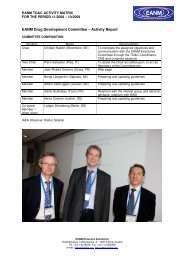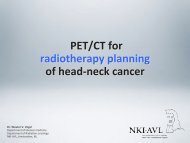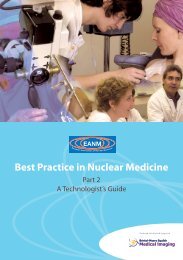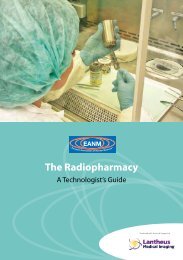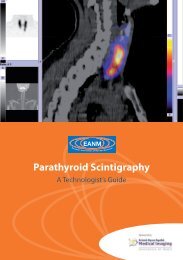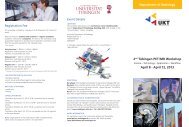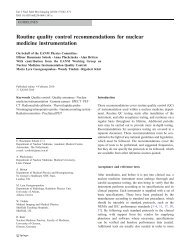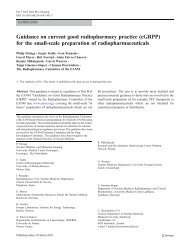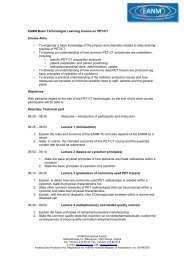Parathyroid Scintigraphy - European Association of Nuclear Medicine
Parathyroid Scintigraphy - European Association of Nuclear Medicine
Parathyroid Scintigraphy - European Association of Nuclear Medicine
Create successful ePaper yourself
Turn your PDF publications into a flip-book with our unique Google optimized e-Paper software.
frequently (about 15% <strong>of</strong> cases) by multiple<br />
parathyroid gland disease (MGD) and rarely<br />
(about 1% <strong>of</strong> cases) by parathyroid carcinoma.<br />
Patients with MGD have either double<br />
adenomas or hyperplasia <strong>of</strong> three or all four<br />
parathyroid glands. Most cases <strong>of</strong> MGD are<br />
sporadic, while a small number are associated<br />
with hereditary disorders such as multiple endocrine<br />
neoplasia type 1 or type 2a or familial<br />
hyperparathyroidism (Marx et al. 2002). Conventional<br />
surgery consists in routine bilateral<br />
exploration with identification <strong>of</strong> all four parathyroid<br />
glands.<br />
Imaging is mandatory before reoperation<br />
For several decades, preoperative imaging was<br />
not used before first-time surgery. Unguided<br />
bilateral exploration, dissecting all potential<br />
sites in the neck, achieved cure in 90–95% <strong>of</strong><br />
patients (Russell and Edis 1982). The two main<br />
reasons for failed surgery are ectopic glands<br />
(retro-oesophageal, mediastinal, intrathyroid,<br />
in the sheath <strong>of</strong> the carotid artery, or undescended)<br />
and undetected MGD (Levin and<br />
Clark 1989). Repeat surgery is associated with a<br />
dramatic reduction in the success rate and an<br />
increase in surgical complications. Imaging is<br />
therefore mandatory before reoperation (Sosa<br />
et al. 1998). 99m Tc-sestamibi scanning (Coakley<br />
et al. 1989) has been established as the imaging<br />
method <strong>of</strong> choice in reoperation <strong>of</strong> persistent<br />
or recurrent hyperparathyroidism (Weber<br />
et al. 1993). In these patients it is necessary to<br />
have all information concerning the first intervention,<br />
including the number and location <strong>of</strong><br />
Chapter 1: Applications <strong>of</strong> parathyroid imaging<br />
parathyroid glands that have been seen by the<br />
surgeon and the size and histology <strong>of</strong> resected<br />
glands. Whichever 99mTc-sestamibi scanning<br />
protocol is used, it is necessary to provide the<br />
surgeon with the best anatomical information<br />
by using both anterior and lateral (or oblique)<br />
views <strong>of</strong> the neck, and SPECT whenever useful,<br />
especially for a mediastinal focus. It is the<br />
author’s opinion that 99mTc-sestamibi results<br />
should be confirmed with a second imaging<br />
technique (usually ultrasound for a neck focus<br />
and CT or MRI for a mediastinal image) before<br />
proceeding to reoperation.<br />
Scanning with 99m Tc-sestamibi is increasingly<br />
ordered on a routine basis for first-time<br />
parathyroidectomy<br />
The first exploration is the best time to cure<br />
hyperparathyroidism. Most surgeons would<br />
now appreciate having information concerning<br />
whereabouts in the neck to start dissection<br />
and the possibility <strong>of</strong> ectopic parathyroid<br />
glands (Sosa et al. 1998; Liu et al. 2005). When<br />
the rare cases (2-5%) <strong>of</strong> ectopic parathyroid<br />
tumours are recognised preoperatively, the<br />
success <strong>of</strong> bilateral surgery can now reach<br />
very close to 100% (Hindié et al. 1997). In the<br />
case <strong>of</strong> a mediastinal gland, the surgeon can<br />
proceed directly with first-intention thoracoscopy,<br />
avoiding unnecessary initial extensive<br />
neck surgery in the search for the elusive<br />
gland (Liu et al. 2005). Preoperative imaging<br />
would also shorten the duration <strong>of</strong> bilateral<br />
surgery (Hindié et al. 1997). By allowing the<br />
surgeon to find the <strong>of</strong>fending gland earlier in<br />
EANM






